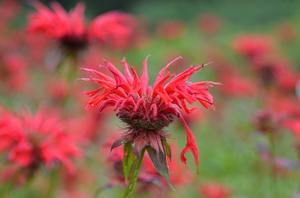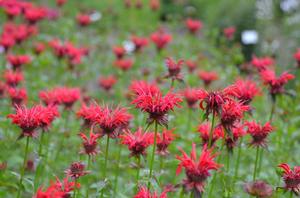Monarda 'Gardenview Scarlet'
Common: beebalmMonarda 'Gardenview Scarlet' - 72 per flat
- Height: 2'-3'
- Spread: 1'-2'
- Spacing: 12"-24"
- Hardiness Zone(s): 3-8


Monarda 'Gardenview Scarlet' - 72 per flat

'Gardenview Scarlet' is one of the most mildew resistant Monarda varieties available. A classic variety that is well-earned, it's rose-red flowers sit on stems rising to 3' tall. Blooming from June to August, this long-flowering Monarda is beautiful, especially when massed in drifts to attract butterflies, bees, and hummingbirds.
Grow in full sun and average to moist soil with good drainage. Water well on planting and regularly until established. Drought tolerant and mildew resistant.
"Monarda ‘Gardenview Scarlet’ is the only true red-flowering cultivar to rate among the top performers. It has large, 4” wide, didyma-like flowers that are great for attracting hummingbirds. ‘Gardenview Scarlet’ shares this and many other traits in common with Monarda didyma ‘Jacob Cline’. However at 36” tall, ‘Gardenview Scarlet’ is approximately 1’ shorter, and in our trial, exhibited more consistent powdery mildew resistance."-Mt. Cuba Center
"Monarda is a genus of about 15 species of annuals and herbaceous perennials from prairies and woodlands in North America. They flower from mid-summer to early fall and are loved by bees, hummingbirds and other pollinators.
Most hybrids are of Monarda didyma parentage and are easily grown in average, medium to wet, moisture retentive soils in full sun to part shade. Those of Monarda fistulosa parentage are more tolerant of drier soils. Prefers rich, humusy soils in full sun, but appreciates some afternoon shade in hot summer climates such as the St. Louis area. Soils must not be allowed to dry out. Remove spent flowers to improve plant appearance and possibly to prolong bloom. Divide clumps every 3-4 years to prevent overcrowding and to control mildly spreading tendencies (slowly spreads by rhizomes). Provide plants with good air circulation to help combat fungal leaf diseases."-Missouri Botanic Garden